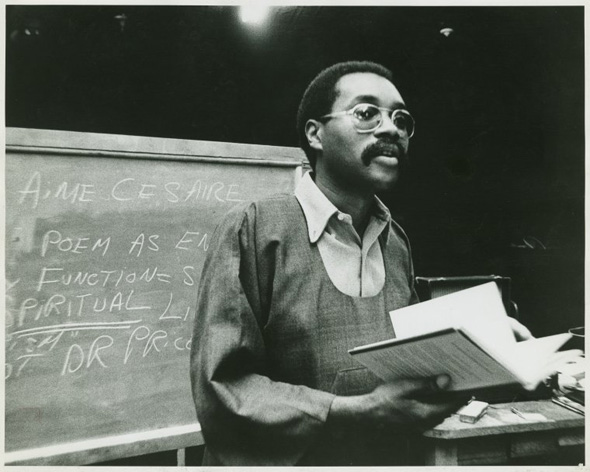
Larry Neal as a teacher. Image from the Schomburg Photo division
Our next class will be with Steven Fullwood from the Schomburg, but in our usual classroom on campus. In preparation for his visit, I’d like you to do an archive assignment that encourages you to use the finding aids we’ve gotten in the past few weeks. You can locate the assignment along with the relevant finding aides in Courseworks (Archival materials folder). Below is my attempt at doing the assignment, so you can get a sense of what I’m looking for. You don’t need to blog your answers, but please do write them down on the assignment sheet.
1). Identify one Schomburg COLLECTION that you might want to review. (The suggested collections list supplied by Steven is in Courseworks).
Collection name and call number: Larry Neal Papers, Sc MG 344
What, if any, restrictions are on this collection? None that I can find
What is interesting to you about the Collection? Larry Neale was an important theorist of BAM who was in Harlem about the same time Shange was at Barnard and published an edition of Zora Neale Hurston’s autobiography, which suggests he didn’t entirely ignore women wroters. He also was specifically interested in music and theater and wrote about some of the same musicians Shange cites.
2). Identify ONE item from the Schomburg archives that you might want to see (it can be in the collection chosen in #1 or not)
Item Name: The Rise of the Black Consciousness in the 70’s
Give series, sub-series and item number if available b. 21 f. 2
Why did you pick this item? This seems to be both about the 70s and written in the 70s, so I’m interested to see if this unpublished essay speaks to what was going on artistically/politically when Shange was working on for colored girls.
3). Identify ONE item from the Ntozake Shange papers that you might want to examine. (The Pathfinder and Collection list are in Courseworks)
Item Name/Title: Flyers for “Ntozake Shange Poetess” at Experience II-Nu’s Black Coffee House in Boston
Give Box and Folder #s: Box 24; folder 3
Why did you pick this item? I was intrigued by the gendered/obsolete “poetess” in the title and am wondering if “Black Coffee House” is also related to some kind of blackness. Since its a flyer, it might be visually interesting as well.
4). Identify ONE item not from the Schomburg or Ntozake Shange papers.
Item Name: I Heard Eric Dolphy in His Eyes 1988
Archive: NYPL Billy Rose Collection
Collection: Circle Repertory Company Papers
Call #, box or other location information: b. 266 f. 7
Why did you pick this item? It says that it’s an unpublished script “with evaluation.” Interested in seeing an unfiltered response to a work in its early stages.
5). What did you discover about the search engines and finding aides while doing this assignment?
Ntozake is occasionally spelled Ntosake! Also, the search by date function is very useful.
6). What were your frustrations in completing this assignment?
Sometimes the NYPL search engine is very slow and I don’t seem to be able to duplicate searches very well. For example, I wrote down the call number of an item, but not the title, went back to the same collection and couldn’t find the item.

